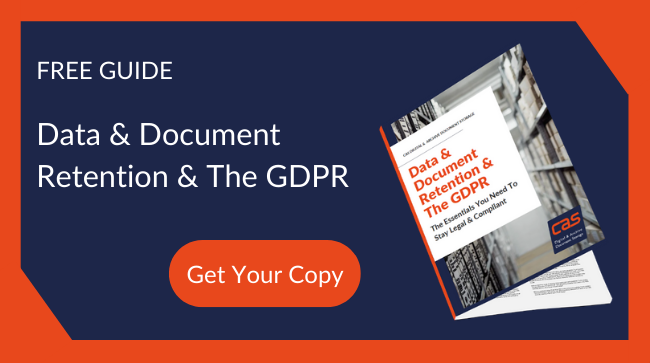If you're new to the world of clinical and medical document storage management, you've probably got quite a few questions.
Retention, storage, and document management can prove complex to understand and tricky to navigate due to the many laws, disposal schedules, and categories involved. Data protection and medical criteria add another layer of complexity on top. Thankfully, it's simple enough to understand medical document storage once you know the basics. Here's CAS's 101 guide to some of our most frequently asked questions:
1) What Archive System Should I Use To Store Medical Records?
It really depends on the medium you're storing your records in (i.e. paper, files, PDF digital copies), the combined volume of the documents, and the level of confidential security required. While a locked drawer might suffice for short-term minutes and active patient files, you'll need something more robust yet searchable for long-term mass retention. If you store your long-term documents on-site, set aside space for a growing archive and work out how you're going to make the best of it. If you've got more than a few binders to deal with, try to organise it as a miniaturised library.
Investing in rolling stacks, shelves, filing cabinets and searchable boxes with divisions can help. Clear binders, tags, and category labels are also a great help. All long-term medical record storage should be kept clean, humidity-free, easy to browse, and protected from wind and UV damage (i.e. sunlight). You should also limit direct access to named personnel with proper data protection training and certification.
2) How Long Do I Need To Keep Medical Records?
Document retention schedules can vary a lot for different categories of medical documents. While some low-priority medical paperwork can be disposed of in as little as six months from creation, vital patient records and hospital admission certificates are often lifelong commitments in the UK.
As a general rule, assume the lifetime of the patient plus eight to ten years after death. Long-term retention laws apply to GP, surgical, dental, and mental health admission records (among others). You can find out more detailed information on disposal schedules via the NHS's 2016 retention guidelines outlined here. You should also be prepared to immediately destroy or modify all copies of a patient's records if they (or a named caregiver) request changes in writing (as per GDPR 2018).
3) I'm Running Out Of Space, Time, Floor And Resources To Manage All Of My Records. What Do I Do?
Get in touch with a specialist third-party archivist, such as CAS. Outsource your storage to a long-stay, high-security, professional-quality archive. It'll help keep your paperwork contained, intact, and ready for use on request. Don't be tempted by cheaper solutions such as storage unit 'dumping'! While they're often a short-term fix, they're vulnerable to theft, decay and poor tracking standards. Data deletion, fraud and breaches often result due to lax standards of care.
4) Can I Store My Records Electronically And Still Keep Them Safe?
Yes. With monitored cloud servers or physical storage media, you can scan (digitise) paperwork and keep it all in one central, observable location. Add encryption and a content management system for even greater standards of digital security. Physical records can often be destroyed once a secure digital copy is created.
5) Once My Records Are Archived, Can I Share Them Again?
It depends. You'll either need direct permission (in writing) from the patient and the GP or a directly relevant medical use for the paperwork. In general, you should try to keep all historic medical documentation available on a strict 'need to know' basis to avoid leaks and privacy violations.
Next Steps
At CAS Ltd, we provide a range of secure document storage and digitisation solutions for UK medical service providers – in the public and private sectors. Please get in touch today to discuss your requirements, and find out how third party storage can improve security, accessibility and compliance.
Image source: Unsplash


